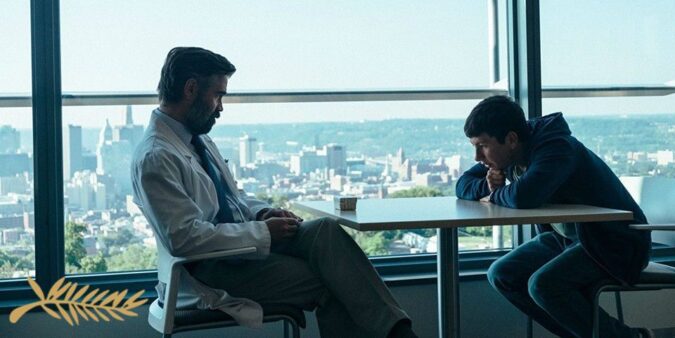We excitedly countdown to the 72nd Festival de Cannes with a different prize winning film each day.
The Killing Of A Sacred Deer, 2017
Prix du scénario – Yorgos Lanthimos, Efthymis Filippou
Yorgos Lanthimos has always been a director to push boundaries, whether that be with the likes of Dogtooth or his latest film, The Favourite. My first introduction to the filmmaker was in 2017 with his psychological horror/family drama/Greek tragedy The Killing of a Sacred Deer.
Watching the film, I couldn’t help but admire the boldness of the writing and the bleak ending which was totally unexpected. Whereas The Favourite gained a lot of buzz during awards season, The Killing of a Sacred Deer proved to be far too diversive and dark for some people to connect with. A film in which a vengeful teenage curses a doctor and his family, based on the greek tragedy Iphigenia in Aulis, is a hard sell to any average cinema attendee.
However, The Killing of a Sacred Deer has a way of invading your mind. It is a film that you can’t quite shake off. The horror lies in the unknown and unexpected. Whether we want to confess it or not, there’s not point denying the fear we feel, that one day the events of The Killing of a Sacred Deer, could happen to you.
Lanthimos seems to understand the power of the horror genre. He is also aware that the genre is very on trend at this current moment. In the last few years we have seen the horror genre evolve with the likes of Raw (2016), Get Out (2017), Mother! (2017) and Hereditary (2018) essentially rewrite the troupes of the genre.
Read Also: Bee’s Around the World in 80 Films – Dogtooth
Although, Sacred Deer is not quite a horror film like Hereditary, it does deals with the similar sort of theme with a family unit collapsing due to an outside force invading their lives. Ever since the 2016 US presidential election and Brexit, there is a sense that an unpredictable chaos in building up in society, and sooner or later we will reach a breaking point.
The Killing of a Sacred Deer follows Dr. Steven Murphy (Colin Farrell) a heart surgeon who, by his own fault, has accidentally killed a patient. Years later, he’s visited by Martin (Barry Keoghan) the son of the deceased. The two of them start a friendship, with Martin even being invited for dinner.
The Murphys welcome Martin, with Steven’s daughter Kim (Raffey Cassidy) growing close to the young man. Martin seems to want Steven to leave his wife (Nicole Kidman) for Martin’s mother (Alicia Silverstone). Steven refuses to do so, and as a result Martin’s behaviour changes.
Then one day, Steven’s son Bob (Sunny Suljic) wakes up paralysed. It turns out that Martin may know what’s going on, so Steven agrees to meet him. Martin gives Steven an impossible decision to make; the man must either kill his daughter, his son or his wife, or all three will die.
At first they will lose the ability to walk, then they will stop eating, and start to bleed out of their eyes, and eventually they will die. Initially Steven dismisses the claims, then Bob stops eating and Kim also loses the ability to walk. It would seem that the ‘curse’ is real and a decision must be made.
Penned by Lanthimos and Efthymis Filippou, the film’s screenplay won the ‘Best Screenplay Award’ at the Cannes Film Festival. All great films are rooted in ancient literature, these are stories which have stood the test of time for a reason.
Read Also: Meet the Jury of the 72nd Festival de Cannes
The myth in which The Killing of a Sacred Deer takes its name from, dates back to 405 BCE. Written by playwright Euripides, the play tells how Agamemnon and his men were stranded on an island by the goddess of the hunt, Artemis. In order to continue onto Troy (where Agamemnon and his men are needed) he has to sacrifice his own daughter, Iphigenia, because he was previously responsible for the death of a sacred deer belonging to the goddess.
The idea of strong, powerful men like Agamemnon and Steven being placed in this position where either outcome is devastating, shows us that the world is chaotic and sometimes great sacrifices have to be made to restore balance and order. If it can happen to the likes of these two great men (who seem to have it all), then it can happen to anyone.
When asked by Katherine Gillespie why he chose to reference the myth in his film, Lanthimos replied “We referenced the story in the film as a reminder that many people have questioned the same issues that are mentioned over time, and many of them we weren’t able to resolve them in any satisfactory way.”
With the character of Martin, Lanthimos stated in an interview that he that [he] “didn’t want him to appear as evil or naïve; we wanted an ambiguity, with elements that you understand. Up to a point, you go with him, and you identify with him and his pain.” Barry Keoghan’s Martin is certainly not evil, but he is someone who is unpredictable. And, unpredictability is a more effective menace. To Martin, this ‘curse’ is what he describes as “the only thing I can think of that’s close to justice…” To Lanthimos, justice is messy and complicated. In real life, there are very little winners, but there are many losers.

